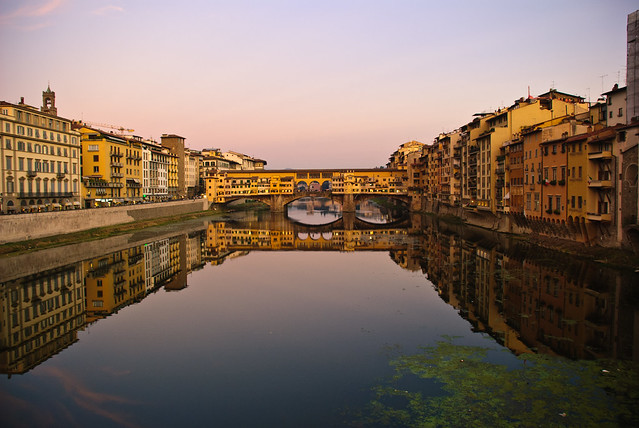Random Posts
France
Spain
UK
‹
›
Travel With Kids
USA
Travel Inspiration
Travel Tips
Ponte Vecchio is one of Florence’s oldest bridges, located on the pedestrianized south of Piazza Della Repubblica towards Palazzo Pitti. It is quite a spectacle as unlike most bridges upon it is 3 stories of shops, some even built outwards form the bridge so they are hanging over the water. The shops used to be mainly butchers up until the 16th century, until Ferdinando I de’ Medici ordered them to be replaced by jewellers and goldsmiths. This was because the butchers would tend to be malodorous and be akin to casting there unwanted remains into the river, which you can easily imagine would not be pleasant.
The bridge still stands today as it was in 1345, and was the only bridge to survive the retreating Germans of the Second World War in 1944. They instead blew up the medieval buildings at either side to prevent access. The only major change that has been made since is to the Corridoio Vasariano, which is an elevated covered passageway joining the Palazzo Vecchio on one side of the bridge, to the Uffizi and Palazzo Pitti on the opposite side. Designed by Vasari for Cosimo I in 1565, it was a kind of private corridor for the Royal Medici family to pass over the bridge unhindered and out of contact with the people they ruled. It was designed and built with small windows to ensure such privacy. However Hitler with his friend and fellow dictator Benito Mussolini decided to have new larger windows put in, as to enjoy an expansive view of the rolling river Arno. Today the corridor is closed for restoration.
Built very close to the Roman Crossing, Ponte Vecchio’s precursor the ‘Old Bridge’ was the only crossing in Florence over the River Arno, up until 1218. The current bridge was built as the result of a flood in 1345 which destroyed the Old Bridge. In November 1966 the bridge narrowly escaped destruction again as the River Arno burst its banks, against all odds holding the monstrous weight of the water and silt.

I think culturally it is a good omen of longevity for Florence that the bridge has been through so much and is still standing. It is one of the most famous images in Florence, an unmistakably distinct landmark. In the middle of the bustling market town it straddles the river, steeped in history like a wise guardian. At night the shut shops look like suitcases over the bridge, and it is a beautiful artifact to behold on an evening stroll or ‘passegiatta’ along the mystical banks of the River Arno. A more recent tradition which has begun to happen is the locking of padlocks to various parts of the bridge, but especially around the railings of the statue of Benvenuto Cellini next to Ponte Vecchio . This has been practiced before in Russia and Asia, and is rumoured to have been started by the padlock shop owner at the end of the bridge. It is said to symbolize a lovers bond; by together locking the padlock and casting the key down into the water it is said to make the bond eternal. The romance only adds further to its charm, a destination not to be missed on a visit to Florence.
About the author: Bill has a taste for Florence ever since his first holiday there over 20 years ago. He highly recommends HouseTrip when looking for a place to stay here.
Images via rayced and -Jerome-
Italy - Travel Inspiration
Subscribe to:
Comments (Atom)




